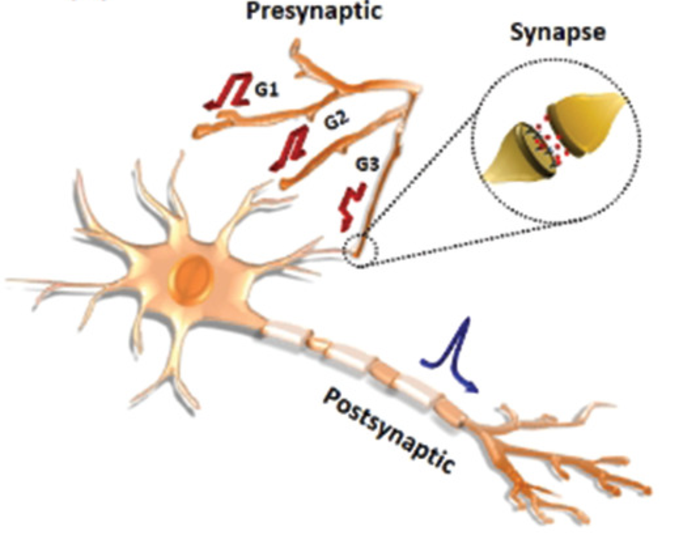Reviewed by Alex SmithSep 24 2021
Ever since artificial intelligence (AI)-based technologies began progressing, there has been a massive increase in the volumes of data available for computers to process.
 Schematic of biological presynaptic and postsynaptic neurons and a synapse (inset). Image Credit: Korea Institute of Science and Technology (KIST).
Schematic of biological presynaptic and postsynaptic neurons and a synapse (inset). Image Credit: Korea Institute of Science and Technology (KIST).
Computing techniques that are currently used often process data in sequence and thus have large power and time requirements for processing huge volumes of information. Hence, a switch to a new computing paradigm is mandatory to solve such challenging matters.
At present, scientists are aiming to design energy-efficient neuromorphic computing technologies and hardware that can process enormous amounts of data by imitating the mechanisms and structure of the human brain.
The Korea Institute of Science and Technology (KIST) announced that a research group led by Dr. Jung ah Lim and Dr. Hyunsu Ju of the Center for Opto-Electronic Materials and Devices has effectively created organic neurofiber transistors with structure and functions quite like those of neurons in the human brain, which can be applied as a neural network.
Studies of devices that can work as neurons and synapses are necessary so that mass computations can be handled in a manner similar to data processing in the human brain.
In contrast to previously created devices that act as either synapses or neurons, the artificial neurofiber transistors created at KIST can imitate the behaviors of both synapses and neurons. By linking the transistors in arrays, a structure similar to a neural network can be easily formed.
Biological neurons possess fibrous branches that can receive numerous stimuli at the same time, and signal transmissions are mediated by ion migrations triggered by electrical signals. The KIST team created the above-mentioned artificial neurofibers using fibrous transistors that they had built in 2019.
They built memory transistors that remember the strengths of the applied electrical signals, similar to synapses, and communicate them through redox reactions between the semiconductor channels and ions inside the insulators upon receiving the electrical stimuli from the neurofiber transistors. These artificial neurofibers also imitate the signal summation capability of neurons.
The scientists produced an artificial neural network system containing 100 synapses using the artificial neurofibers and confirmed the stability of the device via speech recognition trials. After training with speech data, the proposed neural network was proven to realize a recognition accuracy of 88.9%.
The novel artificial neurofiber device is an original technology that can be used to create large-scale, energy-efficient (~2 pJ/signal), and highly reliable artificial neural networks similar to that of the brain. Our artificial neurofiber device is flexible and may be used in AI-enabled wearable electronics made of semiconductor materials or in robotics.
Dr. Jung Ah Lim and Dr. Hyunsu Ju, Center for Opto-electronic Materials and Devices, Korea Institute of Science and Technology
The study was supported by the Ministry of Science and ICT and carried out as part of an institutional research program of KIST and the National Research Foundation of Korea’s mid-career Researcher Program. The research paper has been published in the latest issue of Advanced Materials.
Journal Reference:
Kim, S. J., et al. (2021) Dendritic Network Implementable Organic Neurofiber Transistors with Enhanced Memory Cyclic Endurance for Spatiotemporal Iterative Learning. Advanced Materials. doi.org/10.1002/adma.202100475.